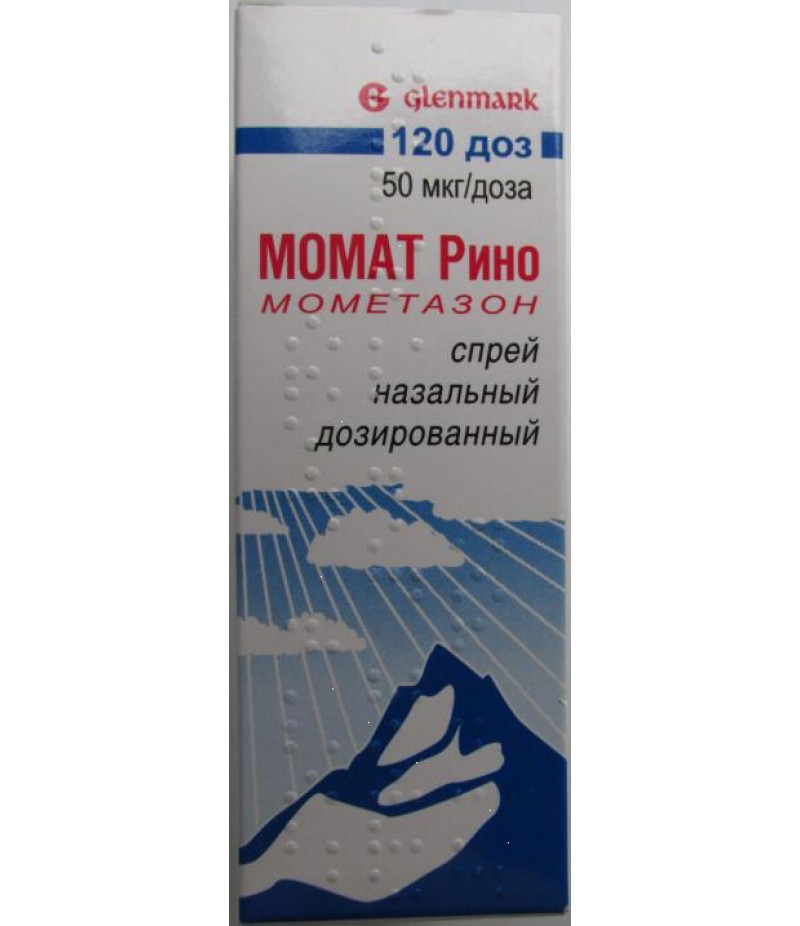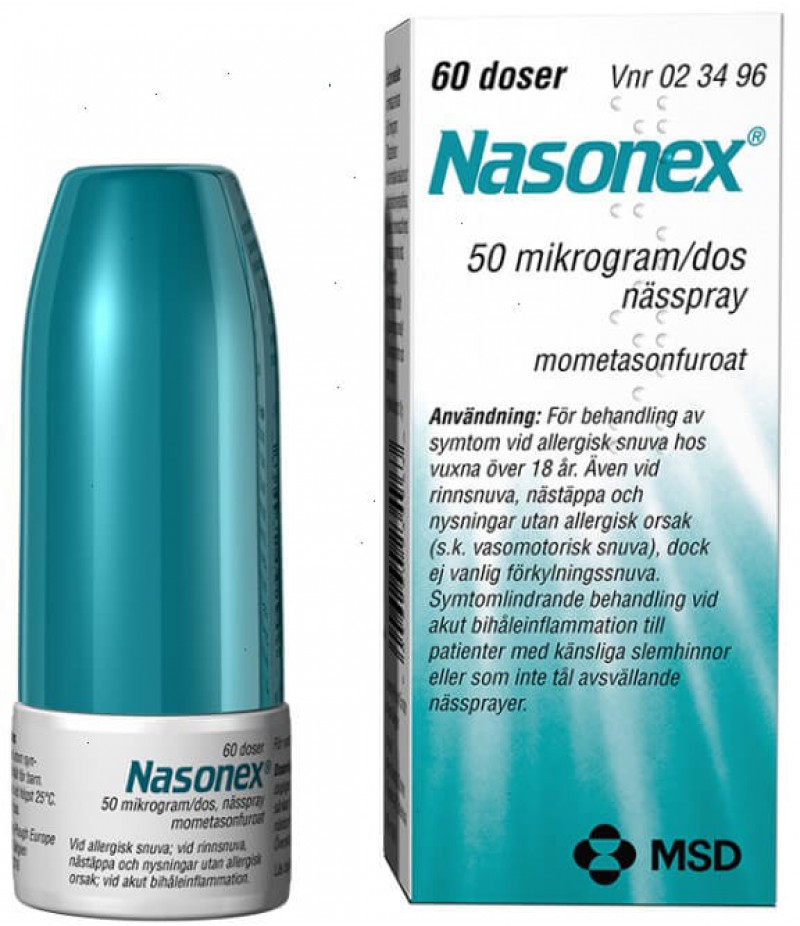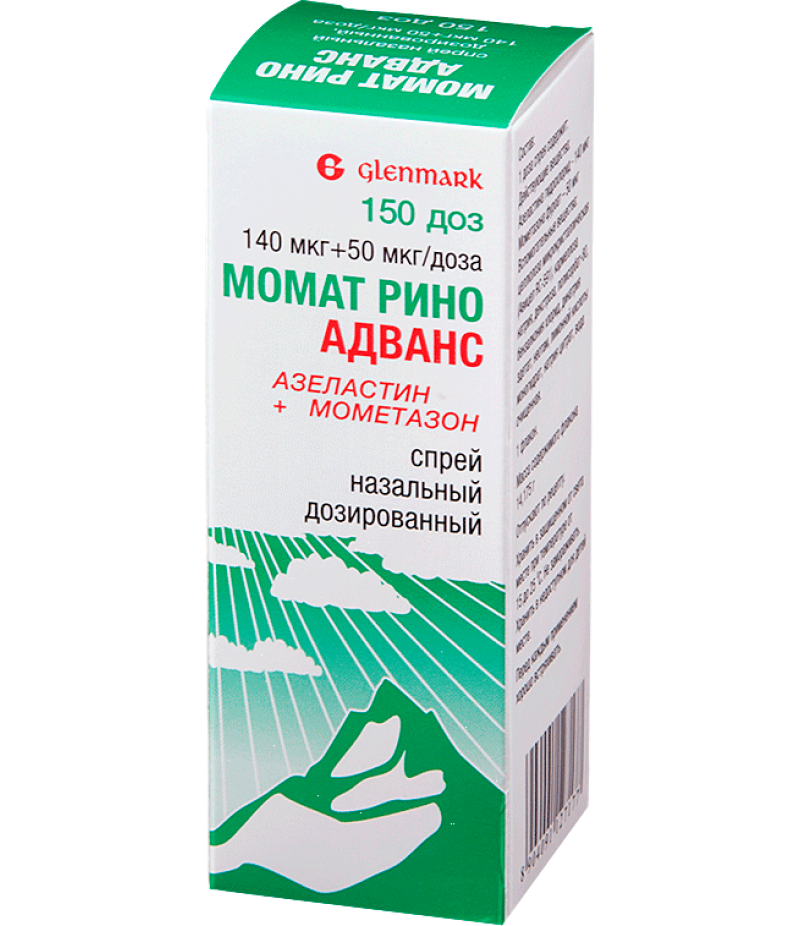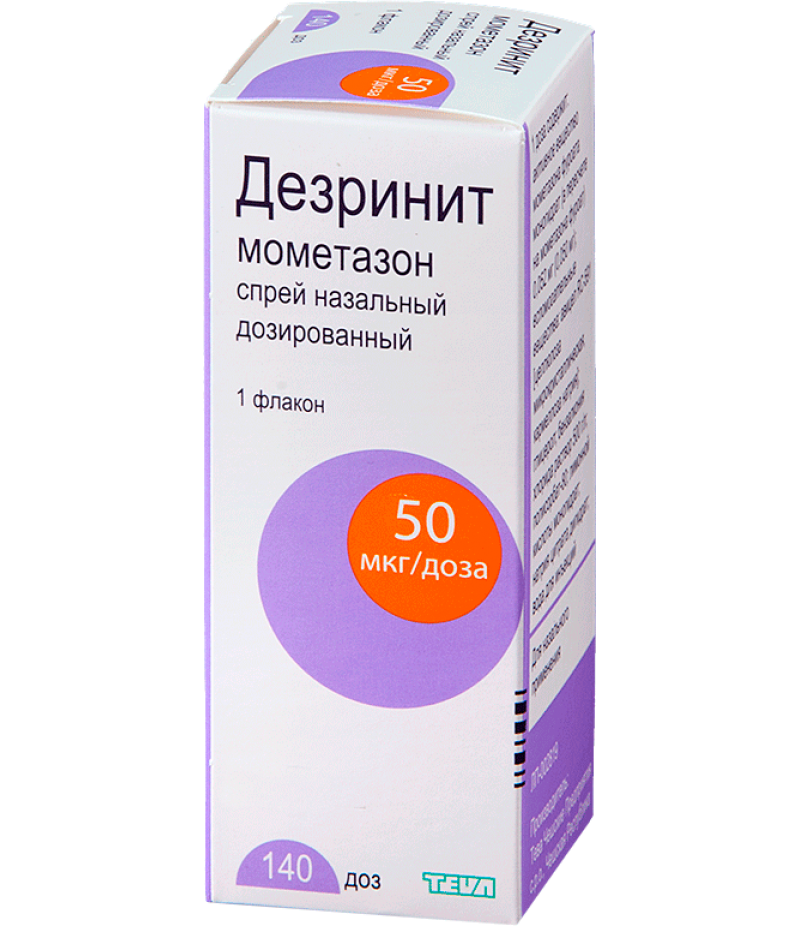Momat Rhino spray 50mcg/dose 120doses
- $22.90
- 3 or more $22.59
- Availability:In Stock
Momat Rhino instructionTo buy Momat Rhino just add it to your shopping cartSee also - Momat Rhino AdvanceComposition1 dose of spray contains:Active ingredient: mometasone furoate monohydrate - 51.72 μg, in terms of mometasone furo..
Tags: spray
Momat Rhino instruction
To buy Momat Rhino just add it to your shopping cart
See also - Momat Rhino Advance
Composition
1 dose of spray contains:
Active ingredient: mometasone furoate monohydrate - 51.72 μg, in terms of mometasone furoate -50.00 μg;
Auxiliary substances: Avicel RC-591 [microcrystalline cellulose, carmellose sodium] - 2.00 mg, glycerol -2.10 mg, citric acid monohydrate 0.20 mg, sodium citrate dihydrate 0.28 mg, polysorbate 80-0 , 01 mg, benzalkonium chloride - 0.02 mg, water for injection - up to 100 mg.
Description of Momat Rhino
From white to almost white, from a translucent to an opaque consistency, a thick slurry.
Pharmacotherapeutic group: glucocorticosteroid for topical application.
ATX code: R01AD09.
pharmachologic effect
Pharmacodynamics
Mometasone is a synthetic glucocorticosteroid (GCS) for topical application. Has anti-inflammatory and antiallergic effect when used in doses, in which no systemic effects occur. It inhibits the release of inflammatory mediators. Increases the production of lipomodulin, which is an inhibitor of phospholipase A, which causes a decrease in the release of arachidonic acid and, accordingly, inhibition of the synthesis of metabolic products of arachidonic acid-cyclic endoperoxides, prostaglandins. It prevents the accumulation of neutrophils, which reduces inflammatory exudate and production of lymphokines, inhibits the migration of macrophages, leads to a decrease in the processes of infiltration and granulation. Reduces inflammation by reducing the formation of the chemotaxis substance (effect on the "late" allergy reaction), inhibits the development of an allergic reaction of an immediate type (due to inhibition of the production of arachidonic acid metabolites and a decrease in the release of inflammatory mediators from mast cells).
Pharmacokinetics
In intranasal application, the systemic bioavailability of mometasone furoate is <1% (with a sensitivity of 0.25 pg / ml). The suspension of mometasone is very poorly absorbed in the gastrointestinal tract, and a small amount of mometasone suspension that can enter the gastrointestinal tract after nasal inhalation is subjected to active primary metabolism even before excretion with urine or bile.
Indications for use
Seasonal and year-round allergic rhinitis in adults, adolescents and children from 2 years of age.
Acute sinusitis or exacerbation of chronic sinusitis in adults (including the elderly) and adolescents with 12 years of age - as an auxiliary therapeutic agent in the treatment of antibiotics.
Acute rhinosinusitis with mild and moderate symptoms without signs of severe bacterial infection in patients aged 12 years and over.
Prophylactic treatment of seasonal allergic rhinitis of moderate and severe course in adults and adolescents from the age of 12 (recommended two to four weeks before the expected beginning of the dusting season).
Polyposis of the nose, accompanied by violation of nasal breathing and smell, in adults (from 18 years).
Contraindications
Hypersensitivity to any of the components of the drug.
Recent surgical intervention or trauma to the nose with damage to the nasal mucosa - until the wound is healed (due to the inhibitory effect of GCS on the healing process).
Children's age (with seasonal and year-round allergic rhinitis - up to 2 years, with acute sinusitis or exacerbation of chronic sinusitis - up to 12 years, with polyposis - up to 18 years) - due to the lack of relevant data.
Carefully
Tuberculosis infection (active and latent) of the respiratory tract, untreated fungal. bacterial, systemic viral infection or infection caused by Herpes simplex with eye damage (as an exception, it is possible to prescribe the drug with the listed infections as directed by a doctor), the presence of an untreated local infection involving the nasal cavity in the mucosa process.
Application in pregnancy and during breastfeeding
Appropriately planned and well-controlled studies of the drug in pregnant women were not conducted.
As with other nasal glucocorticosteroids, Momat Rhino should be given to pregnant or breast-feeding women only if the expected benefit of the drug justifies the potential risk to the fetus or infant.
Infants whose mothers received SCS during pregnancy should be carefully screened for possible hypofunction of the adrenal glands.
Dosing and Administration
Intranasal. Inhalation of the suspension contained in the vial is carried out by means of a special dispensing nozzle on the vial.
Before the first application of the Momat Rhino nasal spray, it is necessary to perform its "calibration". Do not pierce the nasal applicator.
To perform the "calibration", you must press the dispensing nozzle 10 times, until then. until the splashes appear, indicating that the preparation is ready for use.
Tilt your head and inject the drug into each nostril as recommended by your doctor.
If the medicinal product has not been used for 14 days or longer, you must press the dispensing nozzle 2 times until splashes appear.
Tilt your head and inject the drug into each nostril as recommended by your doctor.
Cleaning the dispensing nozzle.
It is important to clean the dispensing nozzle regularly to avoid improper operation. Remove the cap that protects the nozzle from dust, then gently remove the spray tip. Rinse the spray tip thoroughly and the dust cap in warm water and rinse under the tap.
Do not attempt to open the nasal applicator with a needle or other sharp object, as this will damage the applicator, as a result of which you may take the wrong dose of the drug.
Dry the cap and tip in a warm place. Then attach the spray tip to the vial and screw the dustproof cap back onto the bottle again. When the nasal spray is used for the first time after cleaning, it is necessary to perform a "calibration" by pressing the dispensing nozzle 2 times.
Before each use, vigorously shake the bottle.
Treatment of seasonal or year-round allergic rhinitis
Adults (including the elderly) and adolescents with 12 years of age:
The recommended preventive and therapeutic dose of the drug is 2 inhalations (50 μg each) in each nostril 1 time per day (total daily dose - 200 μg). When the therapeutic effect for maintenance therapy is achieved, it is possible to reduce the dose to 1 inhalation in each nostril 1 time per day (the total daily dose is 100 μg).
If the symptoms can not be reduced by applying the drug at the recommended therapeutic dose, the daily dose can be increased to 4 inhalations in each nostril once a day (total daily dose of 400 μg). After reducing the symptoms of the disease, a dose reduction is recommended.
The onset of the drug is usually observed clinically within 12 hours after the first use of the drug.
Children 2-11 years old:
The recommended therapeutic dose is 1 inhalation (50 μg) in each nostril 1 time per day (total daily dose is 100 μg).
The use of the drug in young children requires the help of adults.
Auxiliary treatment of acute sinusitis or acute chronic sinusitis
Adults (including the elderly) and adolescents with 12 years of age:
The recommended preventive and therapeutic dose of the drug is 2 inhalations (50 μg each) in each nostril 2 times a day (total daily dose - 400 μg). If the symptoms can not be reduced by applying the drug at the recommended therapeutic dose, the daily dose can be increased to 4 inhalations in each nostril 2 times a day (total daily dose 800 mcg). After reducing the symptoms of the disease, a dose reduction is recommended.
Treatment of acute rhinosinusitis without signs of severe bacterial infection:
The recommended dose for adults and adolescents is 2 inhalations (50 μg per each nasal passage) 2 times a day (total daily dose of 400 μg). If symptoms worsen during treatment, specialist consultation is necessary.
Treatment of polyposis of the nose
Adults (including the elderly) of 18 years:
The recommended therapeutic dose of the drug is 2 inhalations (50 μg each) in each nostril 2 times a day (total daily dose - 400 μg).
After reducing the symptoms of the disease, it is recommended to reduce the dose to 2 inhalations (50 μg each) in each nostril 1 time per day (total daily dose - 200 μg).
Side effects of Momat Rhino
Adults and teenagers.
Undesirable effects associated with the use of the drug (≥1%), revealed in clinical trials in patients with allergic rhinitis or polyposis of the nose, and during the post-marketing use of the drug, regardless of the indication for use are presented below. Undesirable reactions are listed in accordance with the classification of the system-organ class, unwanted reactions are classified according to the frequency of occurrence. Nasal bleeding, as a rule, was moderate and stopped on their own, the frequency of their occurrence was slightly greater than when using placebo (5%), but equal to or less than with the appointment of other intranasal GCS, which were used as active controls (some of them the incidence of nasal bleeding was up to 15%). The incidence of all other adverse events was comparable to the incidence of their occurrence with a placebo.
The frequency of unwanted reactions is established as follows: very often (≥1 / 10); often (≥1 / 100, <1/10); rarely (≥1 / 1000, <1/100). For unwanted reactions during the post-registration period, the frequency is not established (it can not be determined on the basis of available data).
Infectious and parasitic diseases - often - pharyngitis, infections of the upper respiratory tract *.
Immune system disorders - frequency not established - reactions of hypersensitivity, including anaphylactic reactions, angioedema, bronchospasm, dyspnea.
Violations from the nervous system - often - a headache.
Disorders from the side of the eye - frequency is not established - increased intraocular pressure, glaucoma, cataract.
Disturbances from the respiratory system, chest and mediastinal organs-very often - nosebleeds **; - often - nosebleeds (ie, obvious bleeding, as well as secretion of blood-colored mucus or blood clots), a burning sensation in the nose, irritation of the nasal mucosa, ulceration of the nasal mucosa; - frequency not established - perforation of the nasal septum.
Disorders from the gastrointestinal tract - often - irritation of the pharynx (sensation of irritation of the mucous membrane of the pharynx) **; - frequency is not established - a violation of taste and smell.
Note: * - was detected with a frequency of "rarely" with the use of the drug twice a day with polyposis of the nose, ** - was detected with the drug twice a day with polyposis of the nose.
Children
Disturbances from the respiratory system, chest and mediastinal organs: nasal bleeding (6%), irritation of the nasal mucosa (2%), sneezing (2%).
Disturbances from the nervous system: headache (3%).
The incidence of these adverse events in children was comparable to the incidence of their occurrence with placebo.
With the use of intranasal GCS, it is possible to develop systemic side effects, especially with prolonged use in high doses.
Overdose
With prolonged use of GCS in high doses, as well as with the simultaneous use of several GCS, oppression of the function of the hypothalamic-pituitary-adrenal system is possible. Due to the low systemic bioavailability of the drug (<1%, with a sensitivity of 0.25 pg / ml), it is unlikely that any accidental or intentional overdose will require any measures other than follow-up with a possible subsequent resumption of the drug at the recommended dose.
Interaction Momat Rhino with other drugs
Combination therapy with loratadine is well tolerated by patients. In this case, there is no effect of the drug on the concentration in the plasma of loratadine or its main metabolite.
special instructions
As with any long-term treatment, patients who use the Momat Rhino nasal spray for several months and longer should periodically check with the doctor for possible changes in the nasal mucosa and the possible development of systemic side effects. In the case of the development of a local fungal infection of the nose or throat, it may be necessary to stop the therapy with the Momat Rhino nasal spray and conduct special treatment. The prolonged irritation of the nasal and pharyngeal mucosa can also serve as a basis for discontinuing treatment with this drug.
Patients who switch to nasal spray Momat Rhino after prolonged therapy with systemic glucocorticosteroids require special attention. Abolition of systemic glucocorticosteroids in such patients can lead to an insufficient adrenal function, the subsequent recovery of which can take up to several months. If signs of adrenal insufficiency appear, you should resume taking systemic glucocorticosteroids and take other necessary measures.
During the transition from treatment with systemic glucocorticosteroids to treatment with nasal spray Momat Rhino, some patients may experience initial symptoms of systemic glucocorticosteroid withdrawal (eg joint and / or muscle pain, fatigue and depression), despite a decrease in the severity of the symptoms associated with the lesion the nasal mucosa; such patients need to specifically convince in the advisability of continuing treatment with nasal spray Momat Rhino. The transition from systemic to local glucocorticosteroids can also cause already existing, but masked by the therapy of glucocorticosteroids of systemic action, allergic diseases such as allergic conjunctivitis and eczema.
Patients treated with glucocorticosteroids have potentially decreased immune reactivity and should be warned of the increased risk of infection if they become infected with certain infectious diseases (for example, chicken pox, measles) and the need for medical advice if such contact occurs .
If signs of severe bacterial infection (eg fever, persistent and sharp pain on one side of the face or toothache, swelling in the orbital or periorbital area) appear, immediate medical attention is required.
The efficacy and safety of mometasone has not been studied in the treatment of unilateral polyps of irregular shape, bleeding polyps, polyps associated with cystic fibrosis and polyps that completely cover the nasal cavity. Unilateral polyps, which are irregularly shaped or bleeding, should be further inspected.
With prolonged use of nasal SCS in high doses, it is possible to develop systemic side effects. The probability of developing these effects is much less than when using systemic GCS, and may differ in individual patients, as well as between different GCS. Potential systemic effects include Cushing's syndrome, characteristic signs of cushingoid, suppression of adrenal function, growth retardation in children and adolescents, cataracts, glaucoma and, more rarely, a number of psychological or behavioral effects, including psychomotor hyperactivity, sleep disturbance, anxiety, depression or aggression (especially in children).
It is recommended to regularly monitor the growth of children receiving long-term therapy with mometasone. If the growth slows down, the current therapy should be reviewed in order to reduce the dose of mometasone to the minimum effective dose, which allows controlling the symptoms of the disease. In addition, you should refer the patient to a consultation with the pediatrician.
Treatment with SCS with higher doses than recommended, can lead to clinically significant suppression of adrenal function. If it is known that high doses of GCS are used, consideration should be given to the possibility of additional use of systemic GCS during periods of stress or planned surgical intervention.
Form of issue
Spray nasal dosed, 50 mcg / dose.
For 60 or 120 doses of the suspension in a vial of high-density polyethylene with a dosing device and a lid of high-density polyethylene. For 1 bottle together with instructions for medical use in a pack of cardboard.
Shelf life - years.
Do not use the drug after the expiration date.
Storage conditions
In the dark place at a temperature of 15 to 25 ° C. Do not freeze.
Keep out of the reach of children.
Leave conditions
To buy Momat Rhino the prescription is not required.





